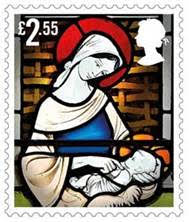
Royal Mail has picked an image from Coalville's Christ Church stained-glass window for its Christmas stamps.
The image from the 1970s window is one of the Christmas 2020 stamp series of six stained-glass Nativity scenes.
Featured, as the £2.55 value stamp, is a section of the stained-glass window from the North chancel lancet window.
Christ Church's Vicar, Revd Gill Pinnington, said: “I'm just glad that our little church here in Coalville has been chosen and has soemthing so lovely to share with the world. We are very proud of our stained-glass windows and are so happy that the beauty of the Mother and Child can be shared with the Nation.”
The stamps are on sale from today (3 November) and will be available at www.royalmail.com/christmas2020, by phone on 03457 641 641 and in 7,000 Post Offices across the UK. In addition, around 1,000 retailers will stock Christmas stamp books this year.
All the stamps showcase the extraordinary detail and craftmanship of this highly specialised decorative art, covering a range of eras, styles and technique.
The Nativity is a common subject in stained glass artistry and from the 13th Century onwards, scenes often focused on the relationship between the new-born infant Jesus and his mother, the Virgin Mary.
Traditionally, stained glass windows are assembled from pieces of coloured glass, held together with lead. The techniques of making stained glass have hardly changed since the Middle Ages.
The other stained glass windows featured inteh stamp series are from the following churches:
• St Andrew’s Church, East Lexham, Norfolk
• St Andrew’s Church, Coln Rogers, Gloucestershire
• Church of St James, Hollowell, Northamptonshire
• All Saints’ Parish Church, Otley, West Yorkshire
• St Columba’s Church, Topcliffe, North Yorkshire
Philip Parker, Royal Mail said: “Our beautiful Christmas stamps feature the Nativity as told through the artistry of different styles of stained-glass windows.”
The origins of stained glass:
Stained glass originated in late antiquity. The Romans were the first to use coloured glass in windows, often set into plaster, stucco or metal frames. The oldest known examples of coloured window glass in England were excavated from the site of the former Anglo-Saxon monastery at Monkwearmouth Jarrow, Northumbria, which was founded in the 7th century.
By the 10th century, stained glass windows were being constructed with lead, which was more malleable and enabled greater versatility of design. Stained glass was a popular and expensive art form in the Middle Ages, used to decorate churches and other prestigious buildings. The translucent qualities of coloured glass meant that these windows projected coloured light into buildings, while illuminating colourful pictures.
Panels of late 12th century stained glass survive at both Canterbury Cathedral and York Minster, but most surviving stained glass in the UK dates from the 13th century onwards. Following the Reformation in the 16th century, fewer religious stained glass windows were commissioned and, with a handful of exceptions, it was not until the 19th century that stained glass once again became a popular art form. Medieval windows provided inspiration for 19th century artists, who revived medieval techniques. Today, exquisite examples can be seen in the windows of our churches, town halls and other public and private buildings across the UK.